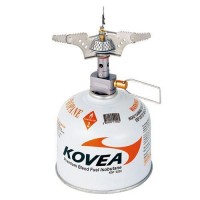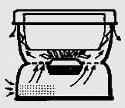Author: Peter Harrison
This is a hot topic on practically every tour that I have done. This article will unravel the mystery. Only gas will be discussed not the various metho and spirit burners.
The gasses used are various mixtures of Butane, Iso Butane and Propane. They are contained in “gas” cylinders or cartridges in liquid form under high pressure. A lot of confusion arises by the use of non scientific names or the use of scientific names loosely and/or incorrectly. Terms such as Butane, Propane, iso butane, iso propane, LPG, iso pro are bandied about & may mean different things in different countries and companies. I have seen one cartridge advertised as a “propane” cylinder but labelled as butane. Probably the cartridge was made in a country where it is normal to call a 70/30 mix of Butane and Propane “Butane” as the major constituent is Butane, and destined to be sold in a country where such a mixture is called “Propane” to distinguish it from what is seen to be the inferior “pure” Butane.
In scientific terms, butane, and propane are have remarkably similar properties, with one significant exception. Both are colourless and odourless gasses heavier than air (At room temperature and pressure). Per gram of gas they both give the same amount of heat and both have the same flame temperature (within a couple of percent). I have been unable to locate similar data for Iso Butane except that it is colourless but has a slight gas smell). However I believe it is similar in characteristics to the others. The significant difference is the “boiling point”. Butane -0.5 oC, Iso Butane -120 C& Propane -43 oC. The gasses are stored in cylinders under sufficient pressure to become liquid. The property of being odourless, colourless, heavier than air & highly combustible makes them very dangerous gasses. In the event of a leak they collect in hollows totally undetected until a spark or flame is introduced. By law in most countries Butane and Propane (and any mixture thereof) must be sold with chemical additives to give them a characteristic smell so that a leak has some chance of being detected. These gasses are very dangerous in boats, kayaks and bob trailers as any leak will be contained within the lower part of the vessel and not be detected until ignited
The higher boiling point of Butane means that Butane has a vapour pressure of 30 psi at 15oC compared with Propane’s 100psi at the same temperature. Iso Butane is I believe between these figures. These pressures mean that cylinders of pure propane need to be much stronger (and much heavier & bulkier) than those for butane. The higher Boiling point of Butane means that at 00C it will not be a gas and will not feed into a burner. Also at temperatures from about 100C the rate of boiling will be very slow restricting the flow of gas to the burner. Much like trying to cook on a nearly empty cylinder. If you only intend to go camping in the Australian summer then a pure butane system may be perfect for you. You may get away with it in winter but it will take longer to boil water etc. In snow it may not light at all.
However, gas doesn’t play fair. The important temperature is that of the gas not the air – sitting on the ground especially if there is dew the temperature of the gas may be much less. In any case, as the gas boils it also cools (this is how air-conditioning works). This will take the temperature of the gas lower than the air temperature. Even if the temperature starts out at 100C as it expels gas its temperature will drop – slowing its rate of giving off gas. (Note if you buy a “Butane” cylinder check carefully – if it says iso butane it will work better at colder temperatures)
100% propane is not ideal either. Although it will give ideal burning down to very low temperatures ( -400C) the bulky cylinders required to contain the gas at “normal” temperatures are not practical to be carried around for portable stoves. A 100% Propane cylinder will be at 600 psi at 800C. Not that much above the temperature in a locked car in the sun on a hot day.
The solution is to use a Butane/Propane mix, or a Butane/Iso Butane/Propane mix. The ratio may vary from 50/50 Butane/Propane to 80/20 Butane/ Propane and sometimes the Iso Butane will be added. Primus for example market a 25/25/50 Butane/Iso Butane/Propane. These give a more practical gas cylinder size and good burning properties over a wide range of temperatures. Gases sold in colder countries tend to have higher Propane content for cold weather performance. Some companies market the same name of gas but with different ratios in depending on the target country of sale. These ratios are determined by each company based on the availability and cost of each gas to them. Some companies are a little coy about publishing the actual ratios – I suspect that they may vary them depending on the cost and availability of the 3 individual gasses. The ratio of gasses makes no difference to the heat output. When burning, they all give the same amount of heat per gram of gas.
Mixing Butane into the Propane reduces the pressure allowing a more practical cylinder to be used. At low temperature the Butane is still burnt, – the boiling of the propane carries with it small liquid particles of Butane to the Burner which vaporises and burns as normal. BUT in cold temperatures around zero degrees or below the propane will burn faster than the Butane & possibly leave some Butane in liquid form when all the Propane is burnt. The gas bottle will be empty of “gas” but you will be able to hear the liquid splashing around. (Of course you can still burn the Butane if the temperature rises later in the day). Iso Butane is frequently used as it reduces the pressure of Propane (not as much as Butane) & also operates at lower temperatures than Butane.
It is interesting to note that no manufacturer of gas cylinders gives any data on the vapour pressure or lowest operating temperature of their gas. Many don’t even give the ratios of the mixtures. The only cylinder I have at home at the moment is an ISOPRO from MSR. The only information on the cylinder says that it is a “Premium Blend Fuel” & “Isobutane Propane”. Their web site says 80/20 but I found another reference that suggests they use 70/30 outside North America. This lack of detailed specification makes it virtually impossible to make a reasoned selection between various brands. I suspect that there is no real difference in cold weather performance between any of the proprietary blends available & they all probably work equally as well down to about -80C. Below this temperature you would be advised to get a stove and fuel designed to work at these extremes rather trying to work out which gas is marginally better than any other
The next point to consider is burning efficiency at normal temperatures. Theoretically, each of the blends will have a slightly different pressure and hence gas flow. Manufacturers will often say that their superior burner technology has been optimised to work best with a Brand of gas mix. I suspect this is pure marketing hyperbole. All stoves have a regulator to turn down the gas flow to the burner. This changes the pressure of the gas to the burner much more than any change in pressure due to the mix. There may be a loss of efficiency due to burner design between stoves designed for 100% Butane and one of the blends when using the other gas.
There are 3 types of connections that I know of – screw, click and pierce. I used to believe this was used to ensure only one type of gas could be used with each type of connection. Research for this article has shown this to be false. It is at the whim of the manufacturers. Primus, for example market the same gas in each of the fitting types.
Conclusions
The only significant difference between all of the various gasses is cold weather performance below about 100C. If this is not a problem to you and Butane is cheaper/more available then use that utilising any of the adapter systems that you can find. If cold weather performance below about 100C then use any of the available butane/propane mixtures. If you are comparing costs remember to compare the cost per gram. The design and pressure of cylinders may mean there volumes are different, check the cost per gram..
If you are concerned about the cost of gas or the amount you need to carry then look closely at the design of your stove. Large losses of heat occur in a typical open unshielded stove which can more than double the amount of gas used. The Trangia designed stoves are very efficient at shielding from wind loss and heat loss out the top of the container.

The design also draws air through giving a much more efficient burn. (Of course the trade-off here is an increase in weight.) Trangia deliberately use a gas hose from the cylinder to the burner to get the gas cylinder away from the heat of the flame. This allows for a very close shield that stops heat loss both wind and radiant heat. As an experiment I heated 500 ml of water in the Trangia with all the shields and lid in place. Took 3 min 30 sec to boil. Removed all the shields and held a second same size pot with a fresh lot of water without touching the regulator. This took 5 minutes to boil. A whopping 43% increase. This was done in still air conditions on my patio. If there was a wind the loss would be much greater (my guess is double)
It is possible to use a windshield to reduce the windloss – all these will do is to stop the loss due to air flow and leave the 43% loss to the surroundings as above. Every stove/gas bottle information site carries a warning. DO NOT USE A WINDSHIELD.
AT first sight this seems to be a ploy by the manufacturer to increase the sale of gas!! The shield that I have seen used by club members would seem to be OK they are normally placed at least 3 cm away from the burner and stop the wind from blowing the heat away. The shields that the manufacturers are worried about are those that try to copy the Trangia principles and enclose the burner and gas bottle. These run the serious risk of reflecting the heat of the burner back onto the gas cylinder. This will cause a large increase in pressure in the cylinder leading to a potential for explosion. If you use any sort of windshield touch the cylinder occasionally – if it is warm to touch then it is being heated – very dangerous.

